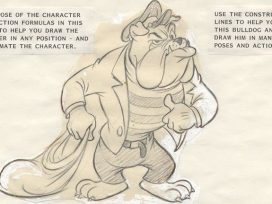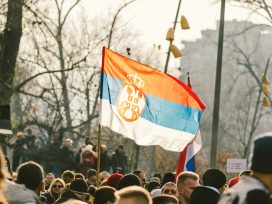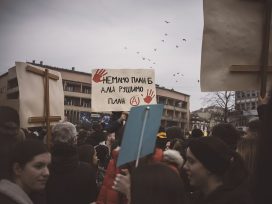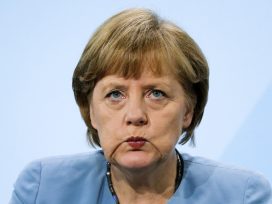In much of the Middle East, the Arab Spring is a spent force, blunted by the resurgence of the ancien regime, as in Egypt, or usurped by religious fundamentalists and bogged down in violence, as in Syria and Libya. It is very much kept alive, however, in the wrath that the Arab peninsula monarchies, hardly affected at the time, continue to rain down on anything that smacks of dissent, of a wish for political organization or that simply reminds people of the heyday of the uprisings when anything seemed possible.
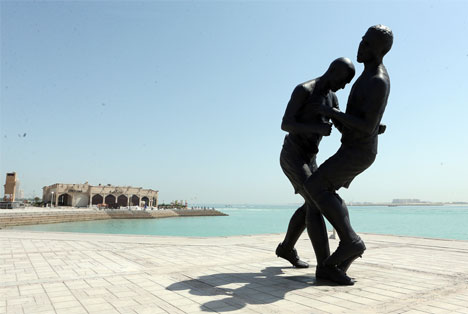
(2012), a sculpture by Algerian artist Adel Abdessemed that depicts French-Algerian footballer Zinedine Zidane head-butting Italy’s Marco Materazzi. In October 2013, the sculpture washastily removedfrom the site pictured above, Doha’s corniche, after an outcry on Twitter of conservatives who deemed it anti-Islamic idolization. Photo: Mohan / Doha Stadium Plus Qatar. Source:Flickr
On 21 March 2014, at the height of the main annual celebration of art in the United Arab Emirates, the Art Dubai art fair, the Emirate’s Culture and Arts Authority shut down an Arab Spring-related photo exhibition at a gallery in Dubai’s financial centre and art gallery hub, DIFC. The show, which had toured Germany and which we’ll elaborate on below, was deemed “a threat to national security.” It is just one, and one of the most egregious, examples of how, even more than three years after the uprisings started shaking the politically somnolent region, nerves are still frayed.
Never the most tolerant and open of societies, the Arab Gulf countries have over the past three years cracked down on even the slightest criticism and the most timid demands for change, with organizations such as Human Rights Watch and Index on Censorship detailing numerous abuses in the UAE, Saudi Arabia and even supposedly more progressive Qatar. The Arab Spring has highlighted the tension between the absolutist rule that continues to be the objective of the Gulf leaders and the image that these monarchies wish to present to the West and that often involves ventures in the field of art and culture.
The West is still coping with the seemingly never-ending aftermath of the economic crisis. Austerity measures have become ingrained in the economic landscape, resulting not only in dramatic budget cuts to arts and cultural infrastructure and in the undoing of decades of creative, intellectual and monetary investment, but also often in hostile attitudes towards anything that involves cultural and intellectual inquiry. In the meantime, countries in the Gulf are throwing lavish amounts of cash at arts and culture.
Tiny oil-rich Qatar, with one of the highest GDPs per capita, is also the world’s biggest contemporary art buyer with Sheikha Mayassa topping ArtReview‘s “Power 100” list thanks to her one-billion-dollar spending budget. The prestige projects of Saadiyat Island in Abu Dhabi, which include a Guggenheim and Louvre, designed respectively by starchitects Frank Gehry and Jean Nouvel, have been eyed with scepticism in terms of audience production and sustainability and have recently also attracted bad press because of the dismal labour conditions of migrant workers. Advocacy groups such as Gulf Labor, a coalition of international artists and art workers, and G.U.L.F. (Global Ultra Luxury Faction) have through petitions, research reports, boycotts and ludic actions questioned the politics and ethics of large Western institutions in cahoots with autocratic regimes.
It is easy to dismiss the developments in the Gulf as prestigious city-branding projects on steroids that solely utilize contemporary art as glam veneer for otherwise absolutist monarchies and conservative societies. It is equally tempting to glorify and celebrate the contemporary art boom and turn a conveniently blind eye to the deeply repressive policies of the Gulf states, as many cash-strapped western museum directors and curators do in the hope of finding a pot of gold at the other end of the rainbow. Both positions are equally pragmatic, but do not necessarily point out the many contradictions and complexities that lie at the heart of the matter.
In a globalized contemporary art world that likes to pride itself on its progressive politics, its engagement with civic society and its continuous critical rethinking of the institutional, a more astute critical position is necessary. The clampdown on freedom of expression and civic liberties in the Gulf Cooperation Council (GCC) since the 2011 uprisings in the Arab world can clarify a lot about the position of art in these places.
The general nervousness in the Gulf about a – very unlikely – spill-over effect was immediately demonstrated at the opening of the 10th Sharjah Biennial in 2011. This ill-fated biennial is best known for the unceremonious sacking of its then director Jack Persekian over Algerian artist Mustapha Benfodil’s installation Maportaliche / Ecritures sauvages (“It has no importance / Wild writings”, 2011), which had caused public outrage.
A less widely publicized incident at that Sharjah Biennial happened when the emirate’s ruler was touring the exhibits. A tiny group of international artists and curators silently protested the deployment of UAE and Saudi troops sent to Bahrain to quell the unrest there. They held up papers of Bahrainis killed in the protests and were promptly arrested and questioned for hours by Sharjah police. It is of course a minor event in the grand scheme of things, yet it is telling that even the most restrained shows of criticism or solidarity at an art event are perceived as a direct threat. It disturbs, after all, the carefully constructed narrative of openness and tolerance.
Emirati and Qatari leaders and officials have not made a secret of the political purpose behind their enormous investment in the arts. Qatar’s Sheikha Mayassa has said that she hopes to challenge western preconceptions about the Muslim world through art: “We want to showcase, with evidence, that Islam is a peaceful religion at the heart of the most intellectually and culturally sophisticated societies throughout history. That is our message.” Officials in the UAE have expressed similar sentiments, wanting to show the rest of the world that the region is not an uncultured wasteland.
Behind such bland assertions of national or regional pride lies a very serious political purpose. The Gulf countries aim to make themselves acceptable as allies of the West and as partners in a wide variety of ventures for international business, whether it is as a trade hub, like Dubai, or as a premier international investor such as Qatar and Abu Dhabi. What better way to disarm western unease over being allied to, and sometimes having to protect, often unpalatable regimes than to co-opt the very intellectuals and cultural operators that would otherwise be most vocal in their condemnation and whose influence has a multiplier effect in the West?
The Arab Spring has been a mixed blessing for the Gulf regimes in that sense. On the one hand they have endured and, through their stability, proven their value to their western allies who, blindsided by the uprisings, have often turned to these Gulf regimes for guidance and even leadership on how to deal with the rest of the region. Hence the free hand that Qatar and Saudi Arabia enjoyed in Syria, where they supported various Islamist factions.
On the other hand, the Gulf regimes have felt threatened by the uprisings. All are ultra-conservative, deeply religious, authoritarian, tribal, clientelist monarchies. And all fear the effects that the Arab Spring might have on their domestic situation, even Qatar, a promoter of the uprisings elsewhere. When Bahrain’s Shia Muslim majority, inspired by the Arab uprisings rebelled in 2011, demanding more freedoms and more of a voice in the running of the country, Saudi Arabia, the UAE and Qatar did not hesitate to send in the tanks to help the country’s ruler crush dissent, so close to home and therefore so dangerous.
Qatar’s championing of the Arab uprisings, which did not extend to its own backyard, has focused on the fundamentalist Muslim Brotherhood, a movement that originated in the 1920s in Egypt but that has spread to most countries in the region and that takes a mostly anti-western stance. The main characteristic of the Brotherhood is that it is both a well-organized political and charitable machine and a claimant to the legitimacy of Islam. As such, it is being regarded as a major threat by the rulers of the UAE and Saudi Arabia. The latter has declared it a terrorist organization. Neither allow any form of political organization in their country and nor does Qatar.
The Muslim Brotherhood briefly ruled Egypt after the first democratic elections there in 2012. While it was supported by Qatar, it was strenuously opposed by Saudi Arabia and the UAE, who had supported the previous regime of Hosni Mubarak. Qatar’s support for the Brotherhood was both financial and through its Al Jazeera Arabic satellite channel, a broadcaster often seen in the West as progressive but in fact regularly an instrument of Qatari foreign policy. After the army overthrew the Muslim Brotherhood in 2013, the new Egyptian authorities cracked down both on the movement and on Al Jazeera, jailing several of its journalists. The UAE and Saudi Arabia also cracked down on the Brotherhood and on Egyptian workers in their countries who might support it. In fact the continued sensitivity to the Arab Spring may well have to do with the presence of many workers from other Arab countries that may be more susceptible to the spirit of the uprisings than the Gulf populations themselves.
Censorship of anything associated with the Arab Spring has steadily continued in the UAE, especially at cultural events under the patronage of the government, like the Art Dubai art fair. Remarkably, images widely available and circulated online, in local newspapers and on the many satellite TV channels become visually undesirable once they lose their news value and are repurposed for art. In 2012 a series of paintings depicting scenes from the aftermath of Egypt’s uprising were removed from the fair. One work was a photo-realist painting depicting the infamous image of “blue bra girl”, the abaya-clad female protestor beaten mercilessly by Egyptian soldiers in Cairo’s Tahrir Square in December 2011. Another painting showed a woman holding men’s underwear with irhal (Arabic for “leave”) – a common chant of protesters – written on them in Arabic. Both works were not particularly interesting conceptually or aesthetically, but the images they were based on have acquired an iconic value, an iconography so it seems, the Emirati authorities would rather stifle than allow.
Commercial galleries in the UAE often have more leeway in the type of shows they can put on and in the boundaries they can push in terms of “cultural sensitivity” (read religion, politics and sexuality). Perhaps this is due to the fact that galleries contribute significantly to turning Dubai into a major commercial (art) hub.
The more shocking was the recent forced closure of the Arab Spring-related inaugural exhibition at East Wing, a gallery focusing on photography in Dubai. The show, Cairo: Open City – New Testimonies from an Ongoing Revolution, curated by German curators Florian Ebner and Constanze Wicke, was closed by the authorities just two days after it opened on 19 March 2014. This non-commercial show had previously toured in the German cities of Braunschweig, Essen and Hamburg and brought together artists, activists, photojournalists and citizen journalists predominantly from Egypt to question how visual media had been transformed by digital technology.
The exhibition was replete with familiar images of hope and despair following the 25 January uprising in Egypt, a revolution that now seems far away as Egypt finds itself again in the iron grips of harsh military rule. Yet the show was not primarily on the Arab Spring as such but rather focused on the changing nature of photography and the power of the image in a region where, as academic Lina Khatib has noted “politics in the Middle East is now seen. The image has claimed a central place in the processes through which political dynamics are communicated and experienced in the region.”
The closure of this large museum-type international exhibition was completely, and perhaps conveniently, ignored in the local UAE press. Only Dubai-based blogger Hind Mezaina posted an item two months after its closure on her blog The Culturist, citing that in her recollection it was the first time ever that a full exhibition was shut down in Dubai. In the world of fast-paced media cycles, these images of the Arab Spring already seem dated and belonging to a different era. These images have carved out their place in history, yet for the Emirati authorities their message is still dangerously potent.
The fact that East Wing is a Qatari initiative based in Dubai, does not help either. As noted earlier, Qatar’s Arab Spring policies and its use of Al Jazeera have not been appreciated by its Gulf neighbours. The closing of the East Wing exhibition came just after that disagreement had erupted into an open diplomatic row, with Saudi Arabia and the UAE demanding that Qatar stop “agitating” against its Gulf allies.
The unwillingness of Gulf populations and censors to be challenged, points at another underlying problem. With few exceptions, home grown and local production of art and culture in the GCC is still nascent. Arab affairs commentator, art collector and member of the Sharjah royal family Sultan Sooud Al-Qassemi might opine that Dubai, Sharjah and Doha are the new centres of the Arab world. In reality, Lebanon, Egypt and Palestine remain the main places of intellectual, artistic and critical discursive production in the Arab world. Other traditional centres, such as Baghdad and Damascus are embroiled in violence.
The Sharjah Art Foundation is one of the few institutions that specifically support artistic production from the region but much more has to be done. In the Gulf’s conservative context much work has still to be done in terms of cultivating a local scene that is other than commercial, and in terms of education and audience-building. The main modus operandi for the Gulf still relies on import as its main strategy: from intellectual and creative labour to manual labour. Importing the discourses and practices of international contemporary art would also necessitate an acknowledgement that art cannot always please everyone and might be abrasive and push boundaries.
More often than not, this commitment to allow art to do what it does best – produce meaning on a variety of different registers – is lacking. Recently, a mild controversy erupted between the Greek government and the Qataris over the showing of ancient nude statues during a sports exhibition on the Olympics in Doha. The Qataris had covered up these statues, and this – even for the recession-struck Greeks – was a bit too much to stomach. The statues were sent back to Athens. French artist Adel Abdessemed’s public sculpture of French-Algerian footballer Zinedine Zidane’s infamous head-butt was hastily removed last October from Doha’s corniche after an outcry on Twitter of conservatives who deemed it anti-Islamic idolization.
The argument is often made in the Gulf that all the foreign art and culture will help educate the population. This has sometimes been framed in almost Victorian terms as the “lifting up” of the people in order to bring them into modernity by exposing them to what the world has to offer.
Yet it remains to be seen whether the small and conservative indigenous populations in places like Qatar and the UAE will widely and regularly access such temples of high art as the Louvre and the Guggenheim and attend talks by affiliated star curators. In any case, how much education can be gained from what can be expected to be relative safe and sanitized programmes? The same question, with relation to academic freedom, can be asked about big-name and ivy-league universities that have set up shop in the region, such as NYU, the Sorbonne, Cornell, Carnegie Mellon and Virginia Commonwealth, to name a few.
These big names in art and education may look good to a super-wealthy population that is used to always purchasing the best, whether Gucci or Guggenheim, but may in the end do little to nurture a bottom-up cultural and intellectual scene. The gap between this ambition and the conservative, religious, tribal and paternalistic Gulf societies remains vast.
The GCC has become a much-wanted host, happy to dish out petrodollars for big events such as the 2020 World Expo to be hosted in Dubai and the contentious 2022 Football World Cup in Doha. Even ISEA, the International Symposium for Electronic Arts that brings together scientists, artists, academics and other practitioners from the technology community, is being hosted by Dubai in 2014.
ISEA has traditionally not shied away from featuring in its programming tactical and activist media practices as an important part of the networked society idea. The question is whether it will stick to that commitment in Dubai. A glance at ISEA’s programme this year reveals only one sub-theme under the rubric “Nomadic Highway / Bridging media” that focuses on social media and its possibilities for art and society.
Though highly exaggerated, social media did play a pivotal role during the Arab Spring, and social media platforms like Twitter, Facebook and YouTube continue to offer activists and citizen journalists, and other factions, platforms of expression. Saudi Arabia boasts one of the highest uses of Twitter and YouTube per capita in the world. In the closed Saudi Kingdom it has become a platform for people to ventilate, meet and discuss reforms (to little effect).
Very safely, the program of ISEA engages with (and celebrates) issues like the Silk Road, the nomadic lifestyle of the Emirati people and the contributions of the ancient Arab world to science, rather than capitalizing more pertinently on the contemporary realities of the region. In a place where a critical Tweet can land you a three-year jail sentence and where an exhibition on social media, technology and the image was just closed down in silence, it remains to be seen how openly and critically the creative and emancipatory potentialities of technology can be discussed.
In fact, the Internet and social media have formed a large part of the post-Arab Spring crackdown in countries such as Saudi Arabia and the UAE. In 2012, the UAE passed a draconic new Internet law, making it an offense to poke fun at the country’s, and its allies’, leaders. People have been arrested in the UAE for Tweets that “promoted strife” or “spread false news”. Of course, the crackdown has not been limited to online activism. The UAE has held mass trials of alleged Muslim Brothers, Emiratis and Egyptians, and sent them to jail. It has also fired and expelled inconvenient foreign academics, such as American journalism professor Matt Duffy in 2012.
Qatar, while being an ostensible supporter of the Arab Spring elsewhere, has jailed poet Mohamed Ibn al-Dheeb al-Ajami to fifteen years in prison for insulting the emir after videos of him reciting his poetry were posted on the Internet. It has also instituted a Qatarization drive, much like other Gulf states, that appears to serve as a cover for strengthening control over media and institutions. The Palestinian director of Al Jazeera has been replaced by a Qatari royal. Other casualties include the heads of the Doha Film Institute and even of the Doha Center for Media Freedom.
Likewise in Saudi Arabia, a December 2013 report by Human Rights Watch documented 11 cases in which the Kingdom had arrested online activists. Saudi Arabia has so far in 2014 condemned several bloggers and other human rights activists to long jail terms, ranging form ten to 15 years. HRW has also criticized new Saudi anti-terrorist legislation as an assault on rights.
The continuing crackdown in Saudi Arabia may have led the country’s rulers to start using arts and culture as a way to show a softer side. Contrary to Qatar and the UAE, where most artistic production is imported, it is mostly Saudi artists who define the very young art scene, probably due to the difficulty foreigners have entering the Kingdom and, even more, due to the problems of importing art works.
The grassroots nature of the Saudi scene has primarily developed due to the trailblazing efforts of the British-Saudi Edge of Arabia platform, founded by British artist Stephen Stapleton and Saudi artists Ahmed Mater and Abdelnasser Gharem, and the Athr Gallery in Jeddah. Nevertheless, the Saudi art scene, though in its infancy, is already globally hyped and commercially inflated with Saudi artist fetching prices of well over 500,000 dollars for their works. Recently the state-owned oil and petroleum giant Saudi Aramco announced plans for a cultural centre of world culture in Dhahran to open in 2015. Already, there are collaborations underway with the British Museum, London’s Natural History Museum and the Centre Pompidou in Paris. In addition, the Saudi authorities have vouched to begin granting tourist visas, recognizing the possibilities of soft diplomacy. It remains to be seen how a closed country with such stark gender segregation, fierce religious Wahabi convictions, no art academies, art degree courses or even cinemas can become an attractive cultural or tourist destination, despite Tate Modern’s director Chris Dercon’s hasty claim that Jeddah now is one of the main art centres in the Middle East.
Were the Gulf countries genuinely interested in becoming the cultural and intellectual centre of the Arab world, as they often declare themselves to be and to which end they spend huge amounts of money, the Arab Spring could have offered a chance of really having an impact. Now more than ever, free and open spaces of artistic, intellectual and political expression are needed in a region in turmoil and transition. Instead, the Gulf countries have clamped down and every time works are censored, public debates are stifled out of fear of reprisals and people are jailed for holding a different opinion, they harm their own case.
